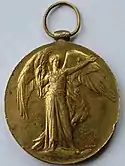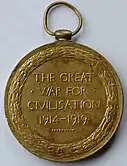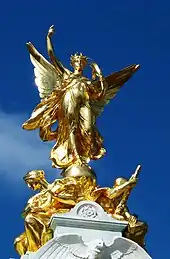Victory Medal (United Kingdom)
The Victory Medal (also called the Inter-Allied Victory Medal) is a United Kingdom and British Empire First World War campaign medal.
| Victory Medal 1914–19 | |
|---|---|
  Obverse and reverse of the medal | |
| Type | Campaign medal |
| Awarded for | Campaign service. |
| Description | Bronze disk, 36mm diameter. |
| Presented by | United Kingdom / British Empire |
| Eligibility | British and Imperial forces. |
| Campaign(s) | First World War 1914–1920 |
| Clasps | None |
| Established | 1 September 1919 |
| Total | Circa 5,725,000[1] |
Ribbon bar Ribbon bar with mention in despatches emblem | |
| Precedence | |
| Equivalent | Victory Medal (South Africa) |
| Related | |
.jpg.webp)
The award of a common allied campaign medal was recommended by an inter-allied committee in March 1919.[2] Each allied nation would design a 'Victory Medal' for award to their own nationals, all issues having certain common features, including a winged figure of victory on the obverse and the same ribbon.[1] Fourteen countries finally awarded the medal.
Eligibility
The Victory Medal (United Kingdom) was issued to all those who received the 1914 Star or the 1914–15 Star, and to most of those who were awarded the British War Medal. It was not awarded singly.[3]
To qualify, recipients need to have served in the armed forces of the United Kingdom or the British Empire, or with certain recognised voluntary organisations, and have entered any theatre of war between 5 August 1914 and 11 November 1918. While home service did not count, United Kingdom based members of the RAF who were actively engaged in the air against the enemy did qualify, as did those who flew new planes to France.[1] Women qualified for this and other First World War campaign medals while serving in nursing and auxiliary forces in a theatre of war.[4]
It was also awarded for mine clearance in the North Sea between 11 November 1918 and 30 November 1919 and for participation in the Allied intervention in the Russian Civil War up to 1 July 1920.[5]
Description

- The medal is bronze, circular and 36 millimetres (1.4 in) in diameter. While originally to be of dull bronze, the final award had a clear lacquer coating, giving it a bright finish.[6] It was designed by William McMillan.[1]
.jpg.webp)
- The obverse shows the winged, full-length, full-front, figure of 'Victory' (or 'Victoria') with her left arm extended and holding a palm branch in her right hand,[7] similar to the statue surmounting the Queen Victoria Memorial, in front of Buckingham Palace in London.
- The reverse has the words "THE GREAT / WAR FOR / CIVILISATION / 1914–1919" in four lines, all surrounded by a laurel wreath.[7]
- The 39 millimetres (1.5 in) wide watered ribbon has an iridescent colour scheme, with the violet moving through to a central red stripe where both schemes meet. It attaches to the medal through a ring suspender.[1]
- The recipient's name, rank, service number and unit were impressed on the edge of the medal. The name of the regiment or corps was omitted on medals awarded to Army officers.[8]
- Those mentioned in despatches between 4 August 1914 and 10 August 1920 wear a bronze oak leaf spray on the medal's ribbon, with a smaller version on the ribbon bar when medals were not worn.[9]
Nicknames
The three First World War medals, either one of the 1914 Star or the 1914–15 Star, the British War Medal and the Victory Medal, were collectively irreverently referred to as Pip, Squeak and Wilfred, after three comic strip characters, a dog, a penguin and a rabbit, which were popular in the immediate post-war era. Pip represented either of the two Stars, Squeak represented the British War Medal and Wilfred represented the Victory Medal.[10]
When only the British War Medal and Victory Medal were worn together, they were referred to as Mutt and Jeff, after contemporary newspaper comic strip characters.[11]
Order of wear
The order of wear of medals awarded for service during the First World War is as follows:[12]
International award
In March 1919 a committee in Paris comprising representatives from the various allied powers recommended the award of an inter-allied campaign medal of common design,[2] thereby avoiding the need for allied nations to exchange campaign medals.[4] Each allied country designed its own version, following certain common criteria. The medal was to be in bronze with a 36 mm diameter, having a winged figure of victory on the obverse, a common inscription on the reverse and suspension by a double rainbow design ribbon.[2] Japan and Siam replaced the figure of victory, since a winged victory symbol was not culturally relevant.[13]
The following versions were finally awarded:[14]
| Country | Designer | Manufacturer | Number issued |
|---|---|---|---|
| Belgium | Paul Du Bois (1859–1938) | ----- | 300,000–350,000 |
| Brazil | Jorge Soubre (1890-1934) | Casa da Moeda – Rio de Janeiro | approximately 2,500 |
| Cuba | Charles Charles | Etablissements Chobillon | 6,000–7,000 |
| Czechoslovakia | Otakar Španiel (1881-1955) | Kremnice Mint | approximately 89,500 |
| France | Pierre-Alexandre Morlon (1878–1951) | Monnaie de Paris | approximately 2,000,000 |
| France[15] | Charles Charles | Etablissements Chobillon | ----- |
| France[15] |
|
----- | ----- |
| Greece | Henry-Eugène Nocq (1868–1944) | V. Canale | approximately 200,000 |
| Italy | Gaetano Orsolini (1884–1954) |
|
approximately 2,000,000 |
| Japan[16] | Shoukichi Hata | Osaka Mint | approximately 700,000 |
| Poland[17] | No medal established | Modern 'fantasy' pieces only | ----- |
| Portugal | João Da Silva (1880–1960) | Da Costa | approximately 100,000 |
| Romania | .... Kristesko | ----- | approximately 300,000 |
| Siam (Thailand)[18] | Itthithepsan Kritakara (1890-1935) | ----- | approximately 1,500 |
| South Africa[19] | William McMillan (1887–1977) | Woolwich Arsenal | approximately 75,000 |
| United Kingdom[20] | William McMillan (1887–1977) |
|
Circa 5,725,000[1] |
| United States | James Earle Fraser (1876–1953) |
|
approximately 2,500,000 |
See also
References
- Hayward; Birch; Bishop (2006). British Battles and Medals (7th ed.). London: Spink. pp. 508–511. ISBN 1-902040-77-5.
- "The Type I Victory Medal 1914–19". Richard Flory. Orders & Medals Research Society Journal, September 2009, page 145
- "The British campaign medals for the Great War". The Long, Long Trail. Archived from the original on 27 February 2008. Retrieved 27 October 2020.
- Dorling, H. Taprell (1956). Ribbons and Medals. London: A. H. Baldwin & Sons. pp. 90–91. OCLC 930416375.
- "Victory Medal, award criteria". North East Medals. Retrieved 7 June 2018.
- "The Type I Victory Medal 1914–19". Richard Flory. Orders & Medals Research Society Journal, September 2009, pages 144–152.
- Mussell, John (ed.). Medal Yearbook 2015. Honiton, Devon: Token Publishing. p. 179.
- "British First World War Service Medals". Imperial War Museum. Accessed 7 July 2018.
- Duckers, Peter (2010). British Gallantry Awards 1855–2000. Oxford: Shire Publications. pp. 54–55. ISBN 978-0-7478-0516-8.
- "Pip, Squeak and Wilfred". First World War.com. Retrieved 7 June 2018.
- "A Guide to British Campaign Medals of WW1". The Great War 1914–1918.
- "No. 38663". The London Gazette (Supplement). 12 July 1949. p. 3404.
- "Inter-allied Victory Medals". Retrieved 9 July 2018.
- The interallied victory medals of World War I by Alexander J. Laslo, Dorado Publishing, Albuquerque. 1986 Edition.
- Unofficial type.
- On the obverse the winged figure of Victory was replaced by a warrior holding a spear.
- Poland did not proceed with the manufacture of any medal. A medal exists that is a "fantasy" piece of modern manufacture.
- On the obverse the winged figure of Victory was replaced by Vishnu riding on Garuda.
- Same as the British version, but with the text on the reverse in English and Dutch.
- Awarded to British combatants and to those from the dominions of Canada, Australia, New Zealand and from the Indian Empire.
Bibliography
- Dorling, H. Taprell (1956). Ribbons and Medals. London: A.H.Baldwin & Sons. OCLC 930416375.
- Hayward; Birch; Bishop (2006). British Battles and Medals (7th ed.). London: Spink. pp. 508–511. ISBN 1-902040-77-5.
- Mussell, John, ed. (20 September 2014). Medal Yearbook 2015. Honiton, Devon: Token Publishing Ltd. p. 177. ISBN 978-1-908828-17-0.
- Williamson, Howard J. (2011). The Great War Medal Collectors Companion Volume I. Privately published by Anne Williamson. ISBN 978-0-9527544-4-2.